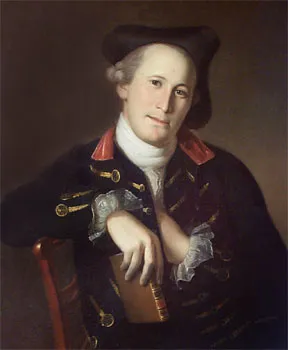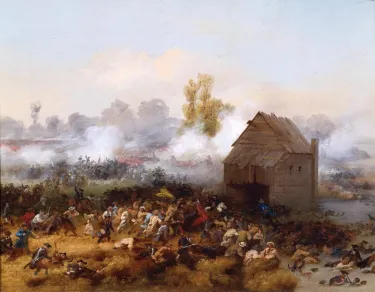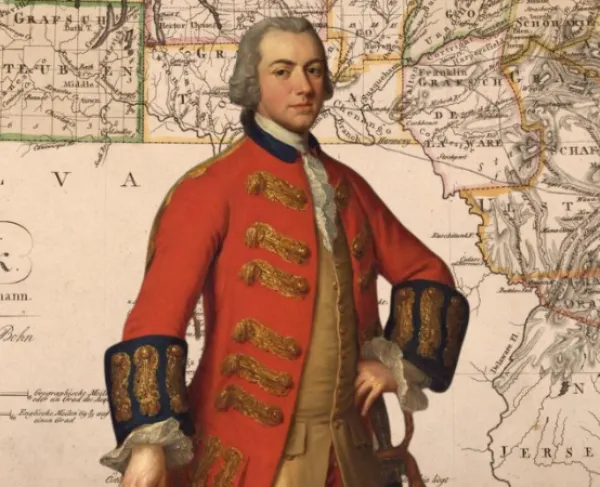
At the corner of Meeting and Broad Streets in Charleston, South Carolina a bronze weather beaten plaque affixed to the walls of Saint Michael’s Episcopal Churchyard reads, “Here in the churchyard of St. Michael’s lie buried two signers of the U.S. Constitution, Charles Cotesworth Pinckney (1746-1825) Lawyer and Legislator, Major General U.S. Army, Minister to France, Presidential Candidate. John Rutledge (1739-1800) Lawyer and Statesman, Governor of South Carolina, Chief Justice of the U.S. Their years of public service, 1762-1825, saw both State and nation well on the road to greatness.” Not too far from the first plaque is affixed a more recent plaque erected in 1961 by the National Park Service declaring that the church and its churchyard are a National Historic Landmark. Behind these mottled with mold, red brick walls also lie the remains of a lesser known American patriot, General Mordecai Gist, a son not of South Carolina, but rather Maryland. His headstone reads the following: “To the Memory of General Mordecai Gist. While in command of the First Maryland Battalion he so valiantly covered the retreat of American forces at the Battle of Long Island, August 1776. That his troops became known as the Bayonets of the Revolution” A Tribute from the Sons of the American Revolution. So who was Mordecai Gist and why has he been lost to the dustbin of American history? Perhaps it is because, in spite of his personal wealth and fortune he put country before self and like many others who served the Continental call died early at age 50 figuring his service would speak for itself.
Gist was born in Baltimore, Maryland in 1743 to Thomas and Susan Gist. His grandfather, Richard Gist, had made a fortune in commercial trade in the bustling seaport, including helping to layout the city. His uncle, Christopher Gist, worked with George Washington to help survey the American frontier. Because of his wealth and family prominence Gist was able to help raise, recruit, and equip at the beginning of the American Revolution an independent militia company known as the Baltimore Independent Company. One thing that set them apart from other militia companies and units raised in the colonies is that Gist’s men were supplied with bayonets. They were also well trained and disciplined before they had their baptism of fire at the Battle of Long Island. This would serve them well on that fateful day. By the time Gist’s men reached New York in the summer of 1776 they had been designated the 5th Maryland Infantry. While Gist had been elected as the captain of his unit (a practice not uncommon in colonial militia units) Congress promoted him to Major General in the Continental Army to which the 5th Maryland had been attached. Because they were well dressed and well equipped, the unit earned the sobriquet, “the Dandy 5th” When they joined the bulk of Washington’s command in New York they were dubbed “macaronis” a pejorative term of the age equivalent of “dandy.” By the end of the fateful Battle of Brooklyn the term “dandy” had a different meaning for Gist and his fellow Marylanders.

After the British evacuated Boston in March 1776, George Washington presciently deduced that the next major British attack would be made against New York City. He ordered his nascent army out of their quarters around Boston and moved to defend New York. The commander had been right. In July 1776, the largest British assault force appeared on the horizon off of New York Harbor. One Continental post said from his position on Staten Island that, “It looked like London all afloat.” The British encountering little resistance disembarked on Staten Island from where they would launch their attack on New York City by way of Long Island and Brooklyn to the East of Manhattan.
Gist’s claim to fame rested on his men’s military attitude and disposition of August 27, 1776. The 5th Maryland had been assigned to William Smallwood’s Maryland Battalion upon reaching New York. Smallwood’s Battalion represented men from across the State of Maryland. Prior to the Battle of Brooklyn, Smallwood’s Battalion was put under the command of General William Lord Stirling.
The overall command of American forces fell on the shoulders of Washington’s most trusted general, Nathanael Greene, but Greene fell ill and was incapacitated, so Washington turned command of his army on Long Island over to General John Sullivan. Sullivan lacked Greene’s tactical skills and that alone may have made the difference in the final outcome.
Washington’s Plan was to form two lines of defense one on Gowanus Heights a rise several hundred yards in front of Washington’s main defensive line on Brooklyn Heights. His total disposition of troops for the battle was 6,000 men. The command of the first American line was given to Sullivan and Stirling.
The defensive position on Brooklyn Heights was led by the aged and grizzled hero of the French and Indian War and the Battle of Bunker Hill General Israel Putnam, who Washington also directed to overseeing the general command of American forces. Washington’s strategy was to hope that Stirling and Sullivan’s line on Gowanus Heights would blunt the British advance and that Putnam’s men would hold their line.
As was typical of Washington’s style of leadership early in the war he failed to reconnoiter his positions and tactically left his flanks unprotected. This would be his army’s undoing at Brooklyn. Loyalists in the area tipped off British commander Henry Clinton that one of the passes that led to Gowanus and Brooklyn Heights was lightly defended by only five members of the local American militia.
Knowing Washington’s disposition British General Henry Clinton conceived a plan in which a feint would be thrown at the American forces on Gowanus, while the bulk of his army slipped through the weakly held American line at Jamaica Pass on the American left. On the evening of August 26, 1776 Clinton ordered his men to move out. By 5:00 am the next morning they had achieved tactical surprise on the Americans. The British force was 20,000 men strong including 5,000 Hessians. In a few short hours and with stealth they had almost encircled the forces on Gowanus heights including the Marylanders. The opening assault on the American position held by Stirling and Sullivan on Gowanus was led by General James Grant. Sullivan and Stirling’s men numbered little more than 2,000 troops. The bulk of the American army, near 6,000 men, defended Brooklyn Heights.
Vastly outnumbered, Stirling tried to inspire his men reminding them of Grant’s pompous boast before Parliament’s House of Commons that he could with five thousand men march across the American continent unimpeded. Addressing his men in the moments before the impending attack Stirling exhorted, “Grant may have 5,000 men now – we are not so many – but I think we are enough to prevent his advancing further on his march over the continent than that mill pond.” Smallwood who had been detached to court martial duty was not present for the battle so the command of all Marylander’s fell to Gist.
The feint worked to perfection, too, as the American commanders erroneously believed that Grant’s movements were the principle attack.
The fighting on the American left was intense and devolved into grim hand to hand combat in which both the bayonet and muskets used like clubs were employed. Men on both sides fell in heaps as the Americans put up a stiff resistance, but the larger numbers of the British overwhelmed them and by 10:00 am the American left collapsed.
An hour earlier, Washington arrived on the battlefield to assume overall command. The Americans still believed that the attack on their left was the main British assault. Stirling’s forces still held the right and center of the American position. All of that changed at 11:00 am when the British launched their main assault against Stirling’s men. It was a classic anvil and hammer maneuver employed by the British. The American line crumbled as the British slipped in to attack Stirling’s rear. Horrified Gist’s men recognized that they, too, had been flanked. Later Gist recalled, “We soon heard the fire on our left, and in a short time discovered part of our enemy in our rear. Surrounded, and [with] no probability of reinforcements, his Lordship ordered me to retreat with the remaining part of our men, and force our way through our camp.” The Hessian’s attacked the American center on Gowanus heights with pure German military precision. When Clinton’s signal gun belched the Germans moved out to dislodge the American position. One eyewitness recounted, “with colors flying, to the music of drums and hautboys as if they were marching across Friedrich’s Platz at Cassel…They did not fire a shot, but pressed steadily forward until they could employ their bayonets. Once breaching the American lines the efficient German butchery began as scores of Sullivan’s men were slaughtered. Stragglers in the woods were hunted down, too, until they too were skewered to death.
Sullivan ordered a retreat to the American lines on Brooklyn Heights. And while most of his made it to the safety of the American position, Sullivan did not and was captured.

The only avenue of escape open to was across a small millpond and Gowanus Creek across from Brooklyn Heights. Stirling ordered his men to pull back with the exception of Gist and his Marylanders, numbering no more than 270 men, who were asked to fight a rearguard action buying time for Stirling’s men and the rest of the American Army. In an act of bravery Stirling remained behind to fight with Gist’s men. Rather than deploy and wait for the enemy to attack Stirling and Gist ordered their men twice to counterattack the British whose numbers ran close to 2,000 men. The British formed a line of battle near the Vechte-Cortelyou House sometimes referred to as the Old Stone House, led by Earl Charles Cornwallis. The scene was dramatically captured by painter Alonzo Chappel in his 1858 painting “The Battle of Long Island.” After the second attack the Marylanders retreated, their numbers well depleted. As they withdrew some of them drowned in the eighty yard-wide creek and others got stuck in the mud only to be felled by British fire. Stirling rather than be captured by the British surrendered to the Hessians. Two hundred and fifty-six Marylanders were killed in the combined assaults, and only twelve managed to safely reach the American position. The rest were captured. Of the furious melee, Capt. Nathaniel Ramsay of Gist’s men recalled, “Our men fought with more than Roman valor.” As the British and their Hessian allies moved in as a pincer to cut off Gist’s men Gist recounted, “Surrounded on all sides by at least 20,000 men, we were drove with precipitation and confusion. The result was a bloodbath as the Hessians and British Highlanders methodically gave no quarter or mercy. One British officer reported, “The Hessians and our brave Highlanders gave no quarters; and it was a fine fight sight to see with what alacrity they dispatched the rebels with their bayonets, after we had surrounded them so they could not resist.” Another British soldier claimed that, “the Americans fought bravely, and (to do them justice) could not be broken till they were greatly outnumbered and taken in flank, front, and rear.” For some Redcoats the carnage was inexcusable one writing after the fight, “We were greatly shocked at the massacre made by the Hessians and Highlanders after victory was decided.”
In part the British used cunning guile to destroy the American force. Gist reminiscing said, “We soon fell in with a party of the enemy, who clubbed their firelocks, and waved their hats to us, as if they meant to surrender as prisoners; but on our advancing within sixty yards, they presented their pieces and fired, which we returned with so much warmth that they soon quitted their post and retired to a large body that was lying in ambuscade. Fortunately for Gist and his men the British overshot the Americans and killed men running in flight. One of Gists men reported, “They entirely overshot us and killed some men away behind in our rear. I had the satisfaction of dropping one of them the first fire I made. As the vortex of battle continued unabated Gist remained on the field with his men. At one point to one of Gist’s men it seemed as if they were the only thing standing to keep the flames of the Revolution burning so the army could escape, Major Gist [and his men] kept the ground, while the rest of the brigade crossed a creek… The major and his party were drove, and I expected never to see them again.” Somehow Gist miraculously survived.
Washington watched the carnage unfold from a nearby knoll and famously was supposed to say, “Good God, what brave fellows I must lose today.” To Private Yankee Doodle, sixteen-year-old Connecticut soldier Joseph Plumb Martin recorded in his wartime chronicle that the survivors emerged “out of the water and mud, to us, looking like water rats.”
In the confusion and fog of war Stirling, too tried to escape with his men after realizing the cause was lost. His attempt to escape the battlefield seemed hopeless, so he gave himself up to the Hessians. Cornwallis offered Stirling high praise later saying, “General Stirling fought like a wolf.”
In spite of the carnage and high percentage of casualties the Marylanders bought precious time for the rest of the American Army. To History they became known as the “Immortal 400.” Looking back on the affair, Gist and his men bought “an hour, more precious to American liberty than any other in history.”
For reasons that remain inexplicable today the British never pressed their advantage and when the day closed the Continental Army badly mauled and bloodied survived to fight on.
For Gist and his men it had been one hell of a baptism of fire. They would continue to fight for the duration of the war and distinguish themselves on various battlefields in both the Northern and Southern Campaigns.
Appointed in January 1779 by Congress to the rank of Brigadier-General Gist was given command of the 2nd Maryland Brigade. That same year he and his men were assigned to the American Army in the South. At the Battle of Camden he once again narrowly escaped death in that grim American defeat. By 1781 as American forces fought through the Carolina’s shadowing Cornwallis and his Army he found himself in October of that year standing amongst the ranks of the American officers who stood next to George Washington accepting the British surrender at Yorktown.
Rather than return home to Maryland he chose to retire after the war and take up the life of a plantation owner outside Charleston, South Carolina. He was married three times and raised two sons whom he named Independent and States. Like others of Washington’s officers of the American Revolution he joined the Society of the Cincinnati serving as the first Vice President of the Maryland chapter. And like others of Washington’s officers he incurred massive debts due to his service in the war and lack of proper compensation by Congress. He died at the age of 49. One of his descendants went on to his own immortality during the Civil War during the equally horrific Battle of Franklin. General States Rights Gist was one of six Confederate generals to die at Franklin as they assaulted an impregnable Union line.
Related Battles
2,000
388





